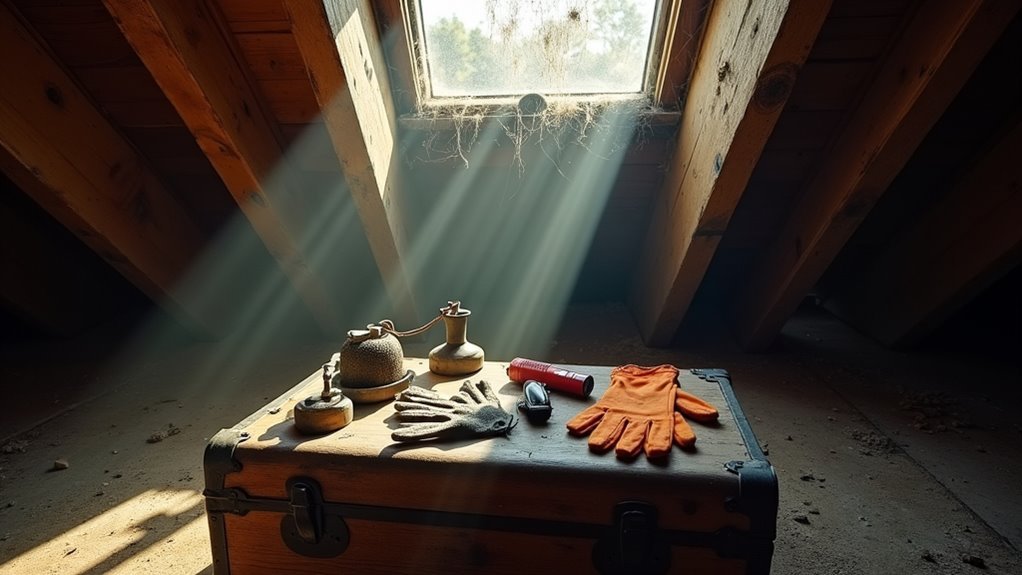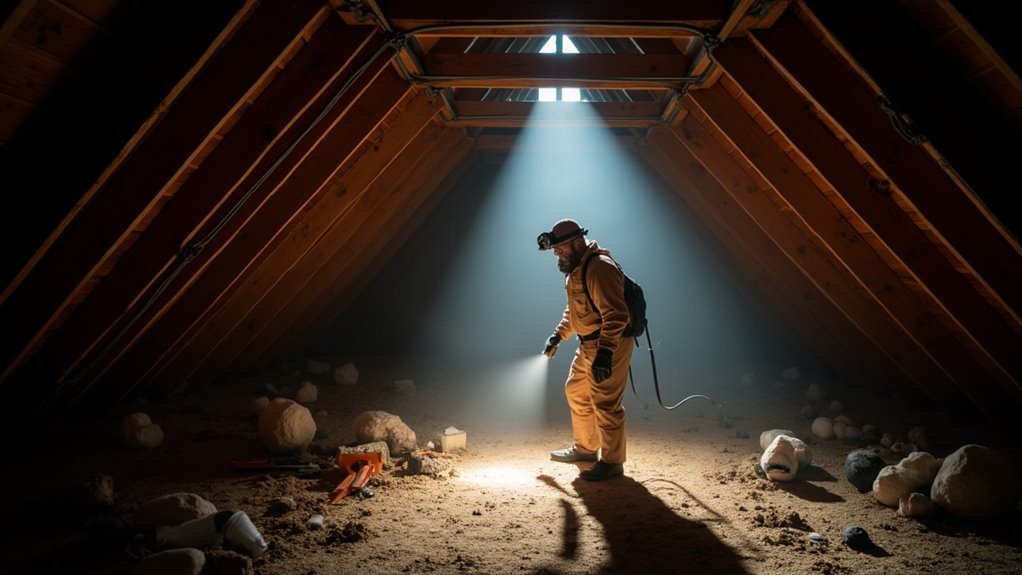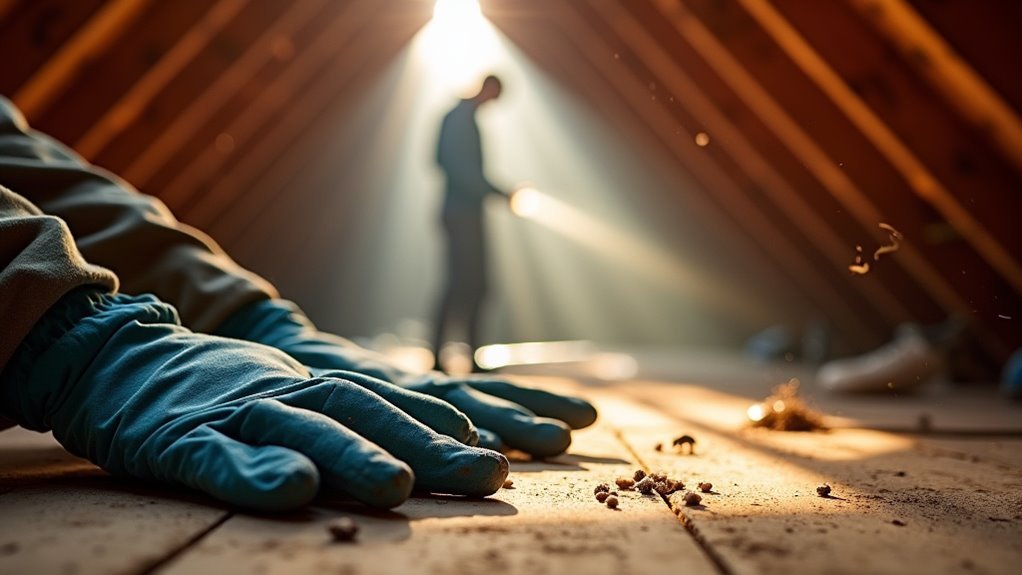You can achieve permanent attic pest control through an all-encompassing approach that starts with thorough inspections to identify entry points as small as 15mm. Focus on sealing gaps with stainless steel mesh and installing vent guards to prevent Norway rats, roof rats, mice, and squirrels from re-entering. After removing contaminated insulation and sanitizing affected areas, implement ongoing monitoring systems with strategically placed sensors for early detection. The following expert strategies will transform your reactive approach into a proactive prevention system.
Understanding Common Attic Pest Species and Their Behavior Patterns

When dealing with attic infestations, you’ll most commonly encounter Norway rats, roof rats, house mice, and Eastern Gray Squirrels, each bringing distinct behavioral patterns that affect your control strategy.
These rodents exploit entry points as small as 15mm, gnawing through wood and insulation to access your attic space.
You’ll identify their presence through specific signs of rodent activity: scurrying sounds overhead, gnaw marks on structural elements, droppings, and scattered nesting materials like shredded insulation.
Understanding their breeding patterns proves essential since rodents reproduce rapidly in favorable conditions.
Squirrels cause extensive damage by chewing electrical wiring, creating fire hazards.
Professional pest control services recognize these behavioral differences, targeting seasonal activity patterns when developing effective elimination strategies for your specific infestation.
Essential Tools and Equipment for Effective Attic Pest Control
You’ll need the right professional trapping equipment to effectively capture attic pests without causing unnecessary harm or stress.
Your trap selection should match the specific species you’re targeting – commercial-grade snap traps work best for rats, while smaller humane traps are ideal for mice.
You’ll also want to invest in quality exclusion materials like stainless steel mesh and expanding foam to seal entry points and prevent future infestations.
Professional Trapping Equipment
The right professional trapping equipment makes all the difference between successful pest removal and ongoing attic infestations.
You’ll need commercial-grade traps specifically designed for rodent control services, ensuring effective capture of rats and mice. Humane traps offer catch-and-release options, supporting ethical pest management practices while safely removing unwanted pests.
Specialized baiting systems work alongside your traps, attracting target species while avoiding non-target captures.
Inspection cameras become invaluable tools for evaluating attic spaces and identifying entry points, enhancing your trapping strategy’s effectiveness.
Expert wildlife removal requires proper training in equipment usage, ensuring compliance with local regulations and maximizing safety throughout the removal process.
This professional approach guarantees efficient pest elimination while maintaining humane standards.
Exclusion Material Selection
Since effective trapping alone won’t solve persistent attic pest problems, selecting the right exclusion material selection becomes critical for long-term prevention.
You’ll need stainless steel mesh for sealing vents and small openings—it prevents gnawing while maintaining ventilation. For larger gaps, expanding foam creates protective barriers and provides insulation against temperature extremes.
High-density foam boards offer superior durability for blocking access points, resisting chewing better than traditional materials.
Weather stripping and rubber gaskets create airtight seals around doors and windows, eliminating entry points effectively.
Don’t overlook attic vent guards—they’re essential for preventing animals from climbing into your attic while preserving airflow.
This thorough approach to exclusion material selection guarantees permanent rodent control by addressing every potential entry point systematically.
Comprehensive Inspection Techniques for Identifying Entry Points

Effective pest control begins with a meticulous inspection that reveals every potential entry point around your property.
Extensive inspections require you to examine your home’s exterior for gaps and cracks larger than 15mm. You’ll need flashlights and mirrors to spot hidden entry points in attics, crawlspaces, and around vents.
During your thorough inspection, watch for these critical signs of rodent activity:
- Physical damage – Look for gnawed wood around entry points and insulation wear from nesting.
- Evidence trails – Check for droppings and nests in secluded areas.
- External pathways – Identify overhanging branches or debris piles that provide roof access.
You should also examine wiring for damage, as compromised electrical systems often indicate active rodent presence and reveal primary access routes.
Humane Trapping Methods for Rodent Removal From Attics
You’ll need to select traps specifically designed for the rodent species you’re targeting, as mice require different approaches than rats.
Your trap placement should focus on areas where you’ve spotted droppings, nests, or other clear signs of activity to maximize capture rates.
You can guarantee safety by choosing non-toxic methods that won’t harm pets, children, or the rodents themselves during the removal process.
Species-Specific Trap Selection
When dealing with rodent infestations in your attic, choosing the right trap for each species makes the difference between success and frustration.
Species-specific trap selection guarantees you’re using humane trapping methods that maximize capture success rates while minimizing animal suffering.
Here’s how to match traps to your unwanted guests:
- House mice – Use non-toxic snap traps designed for smaller rodents, as they’re perfectly sized for effective capture.
- Norway and roof rats – Deploy commercial-grade traps built to handle larger, stronger rodents safely.
- All species – Focus on strategic placement of traps along walls and near food sources where rodent activity is highest.
Strategic Placement Techniques
Selecting the perfect trap means nothing without proper placement strategy. Strategic placement determines your success in humane trapping methods for rodent removal. You’ll trap and remove rodents effectively by positioning devices where you spot visible signs of rodent activity like droppings, gnaw marks, or urine stains.
| Location | Signs to Look For | Placement Tips |
|---|---|---|
| Wall edges | Droppings, grease marks | Place traps perpendicular to walls |
| Entry points | Gnaw marks, holes | Position traps 2-3 feet from openings |
| Insulation areas | Nesting materials | Set traps near disturbed insulation |
| Corners | Urine odor, tracks | Angle traps toward corner intersections |
| Beam intersections | Scratching sounds | Secure traps to prevent falling |
Use attractive bait specific to your target species. Regular monitoring guarantees ongoing control while allowing trap repositioning based on changing activity patterns.
Non-Toxic Safety Methods
Safety takes precedence when implementing humane removal methods for rodent removal from attics.
You’ll benefit from non-toxic traps designed specifically for different species, guaranteeing effective capture without causing harm. These expert solutions utilize eco-friendly materials that align with sustainable pest control practices.
When you strategically place traps in high-activity areas, you’ll maximize capture rates while protecting non-target wildlife:
- Catch-and-release traps for mice minimize stress and injury
- Commercial-grade traps for rats guarantee safe, effective removal
- Trained technician placement optimizes trap positioning for success
The removal process doesn’t end with capture.
You’ll receive extensive sanitization services that eliminate health risks associated with droppings and nesting materials, guaranteeing your attic remains clean and safe for your family.
Professional-Grade Exclusion Strategies to Prevent Re-Entry
After implementing initial pest control measures, professional-grade exclusion strategies become your strongest defense against re-entry.
Trained technicians conduct extensive inspections to identify vulnerable areas, then seal entry points as small as 15mm using durable materials like stainless steel mesh. These exclusion services include installing vent guards and capping chimneys to block wildlife access to your attic.
You’ll protect your property from structural damage while eliminating health risks associated with rodent infestations.
A thorough exclusion plan addresses every potential entry point that pests might exploit. Many companies offer a lifetime guarantee on their work, ensuring you won’t pay extra if rodents breach previously treated areas.
This extensive approach provides lasting protection and peace of mind for your home.
Contamination Assessment and Damage Evaluation Protocols

Professional technicians begin contamination assessment by systematically examining your attic for rodent droppings, urine stains, and nesting materials that create serious health hazards.
This thorough damage evaluation identifies the full scope of rodent activity affecting your property’s safety.
Professional cleanup services follow these essential protocols:
- Inspect structural elements – Check insulation, wiring, and beams for gnaw marks and degradation.
- Document contamination levels – Map affected areas to determine remediation efforts required.
- Assess replacement needs – Evaluate whether attic insulation requires complete removal due to contamination.
Accurate damage evaluation directly influences your pest control strategy and helps prevent future infestations.
The assessment results determine whether you’ll need partial cleaning or extensive insulation replacement, ensuring your attic returns to a safe, functional condition.
Safe Cleanup Procedures for Attic Pest Droppings and Debris
When you’re dealing with attic pest infestations, you’ll need to conduct a thorough health hazard assessment before starting any cleanup work, as rodent droppings can harbor dangerous pathogens like Hantavirus.
You’ll want to implement professional sanitization methods that go beyond basic cleaning to eliminate disease-causing bacteria and persistent odors that attract new pests.
Proper contaminated material disposal requires specialized handling and biohazard protocols to protect both your family’s health and the environment.
Health Hazard Assessment
Since attic pest droppings harbor dangerous pathogens like Hantavirus and Salmonella, you’ll need to approach cleanup with extreme caution to protect your health.
A thorough health hazard assessment reveals why professional cleanup procedures are essential for your safety.
When evaluating contamination risks, consider these critical factors:
- Pathogen exposure levels – Determine the extent of harmful pathogens present in droppings and urine-soaked materials.
- Airborne particle risks – Assess potential inhalation hazards when disturbing contaminated debris.
- Contact contamination zones – Identify all surfaces requiring specialized cleaning solutions and sanitization.
You’ll need proper protective gear including respirators and gloves before beginning any cleanup.
Professional attention to detail during sanitization prevents lingering odors that attract new pests, ensuring effective reinfestation prevention while maintaining your attic’s safety.
Professional Sanitization Methods
After completing your health hazard assessment, you’ll need specialized sanitization methods that go far beyond standard cleaning procedures.
Professional sanitization begins with sealing the contaminated area and wearing protective gear to prevent exposure to rodent feces carrying Hantavirus and salmonellosis. You’ll require EPA-approved disinfectants and HEPA vacuums to capture debris while preventing airborne contaminants from spreading throughout your home.
The thorough cleaning process involves systematically removing all droppings, followed by detailed inspection and sanitation of insulation and structural elements.
This eliminates lingering odors that attract pests and helps prevent future infestations.
Professional services guarantee safe disposal of hazardous materials while minimizing health risks, ultimately restoring your attic’s environment and protecting your property’s integrity.
Contaminated Material Disposal
Following proper sanitization protocols, you must handle contaminated material disposal with extreme care to protect yourself from dangerous pathogens. Rodent droppings and nesting debris carry serious health risks including Hantavirus and salmonellosis, making proper cleanup essential.
Essential disposal steps include:
- Wear complete personal protective equipment – gloves, masks, and goggles prevent exposure to harmful contaminants.
- Use disinfectant spray on all contaminated materials – dampen droppings with disinfectant to minimize airborne dust particles.
- Seal everything in plastic bags – contaminated insulation and debris must be double-bagged before disposal.
After removing all contaminated materials, thorough sanitization of affected areas neutralizes odors and prevents future infestations.
Choose eco-friendly disinfectants when possible to maintain environmental safety while effectively eliminating pathogens and reducing pest attraction.
Insulation Replacement and Restoration After Pest Removal
When pests invade your attic or crawl spaces, they often leave behind more than just memories of their unwelcome stay. Contaminated insulation poses serious health risks from droppings and urine, requiring immediate attention after pest removal.
Professional services assess damage extent and recommend insulation replacement when necessary to eliminate odors and contaminants.
Attic restoration involves thorough cleaning and sanitization, creating a safe environment while improving indoor air quality.
Modern materials like pink spray-in fiberglass enhance energy efficiency, particularly beneficial in Houston’s climate where temperature control directly impacts utility costs.
Replacing damaged insulation doesn’t just restore comfort—it helps prevent future infestations by eliminating pest-attracting odors and creating an inhospitable environment for rodents and other unwanted visitors.
Sealing and Weatherproofing Vulnerable Attic Access Areas
Since rodents can squeeze through openings as small as 15mm, identifying and sealing every potential entry point becomes your most critical defense against future infestations.
Effective weatherproofing requires systematic inspections of vulnerable access points throughout your attic space.
Focus on these essential sealing strategies:
- Install stainless steel mesh over vents and openings, as it’s gnaw-resistant and provides lasting vent protection.
- Add vent guards to roof areas where climbing rodents typically access your attic.
- Cap chimneys properly and verify all vents fit securely to eliminate gaps.
Regular inspections help you catch new vulnerabilities before they become rodent entry points.
Ongoing Monitoring Systems for Early Detection of Future Infestations
While sealing entry points provides your primary defense, implementing ongoing monitoring systems transforms your pest control approach from reactive to proactive.
These advanced systems use strategically placed sensors and cameras throughout your attic to provide early detection of rodent activity before infestations become serious problems.
Strategic sensor placement and camera monitoring throughout attics enables early rodent detection, preventing minor issues from escalating into costly infestations.
You’ll receive real-time alerts whenever the system detects pest presence, allowing immediate action to prevent extensive damage.
The monitoring technology identifies entry points and conditions that attract rodents, greatly reducing severe pest problems through continuous surveillance.
Many systems integrate seamlessly with smart home technology, giving homeowners convenient control over their pest management strategy.
When combined with your exclusion efforts, ongoing monitoring systems enhance overall effectiveness and deliver superior long-term results for permanent attic protection.
Seasonal Maintenance Schedules for Long-Term Pest Prevention
Although monitoring systems provide excellent real-time detection, establishing a thorough seasonal maintenance schedule guarantees you’ll catch potential problems before they develop into serious infestations.
Your proactive measures should focus on three critical seasonal activities:
- Spring and Fall Thorough Inspections – Align with peak breeding seasons to identify entry points and signs of rodent activity like droppings or gnaw marks.
- Quarterly Cleanings and Sanitization – Remove pheromones and nesting materials that attract pests to your attic space.
- Preventive Treatments Application – Integrate eco-friendly repellents during maintenance visits to maintain year-round protection.
These scheduled interventions prevent future infestations by addressing vulnerabilities before pests establish themselves.
You’ll save money and avoid damage by catching problems early rather than dealing with full-blown infestations later.
Health and Safety Protocols During Attic Pest Control Operations
When dealing with attic pest control, your safety and that of the technicians becomes paramount due to the serious health risks associated with rodent droppings, urine, and contaminated materials.
Professional technicians wear essential personal protective equipment including masks, gloves, and goggles to prevent pathogen exposure. They conduct extensive assessments for hazardous materials like mold or asbestos that may accompany infestations.
Certified technicians utilize comprehensive protective gear and conduct thorough hazardous material assessments to ensure safe pest control operations.
Proper biohazard remediation practices guarantee contaminated materials are handled and disposed of safely.
After removal, thorough sanitization procedures using eco-friendly, non-toxic cleaning agents eliminate residual contaminants.
You’ll benefit from knowing that technicians receive regular training sessions to stay current on the latest health and safety protocols, creating a secure environment for everyone involved during these critical operations.
Frequently Asked Questions
How Much Does It Cost to Rodent Proof an Attic?
You’ll spend $200 to $1,500 for rodent proofing your attic, depending on infestation severity and repairs needed. Professional inspections cost $50-$150, while sealing entry points adds $1-$5 per linear foot.
How Do I Force Rodents Out of My Attic?
You’ll need to seal entry points, set humane traps, use peppermint oil deterrents, trim overhanging branches, and thoroughly sanitize the space afterward to eliminate food sources that’d attract more rodents.
Does Professional Pest Control Work?
Yes, professional pest control works effectively. You’ll get trained technicians using targeted methods, species-specific trapping, and exclusion techniques. They’ll provide extensive services including removal, cleaning, and sanitization with satisfaction guarantees backing their results.
How Do You Seal an Attic From Pests?
You’ll need to identify and seal gaps larger than 15mm using stainless steel mesh and caulking. Install vent guards, cap chimneys, repair window screens, and trim overhanging branches for complete protection.
In Summary
You’ve now got the complete toolkit for permanent attic pest control. Don’t wait for infestations to worsen—implement these professional strategies immediately. Start with thorough inspections, use humane removal methods, and seal every entry point you find. Stick to your seasonal maintenance schedule and monitor regularly. Remember, consistency’s key to long-term success. If you’re dealing with severe infestations or safety concerns, don’t hesitate to contact professional pest control services.




Leave a Reply